CQUniversity COIT20261 Network Routing and Switching Assignment 2
VerifiedAdded on 2021/05/30
|8
|2309
|89
Homework Assignment
AI Summary
This assignment solution addresses key concepts in network routing and switching, focusing on a written assessment for the COIT20261 course at CQUniversity. The assignment covers a range of topics, including routing table analysis, next-hop address determination, and network hop calculations based on provided network diagrams. It delves into IPv4 fragmentation, requiring calculations of fragment sizes, offsets, and an understanding of fragmentation's impact on datagram size. Furthermore, the assignment explores TCP congestion controls, prompting an analysis of current methods, particularly the BBR protocol developed by Google. Students are asked to summarize congestion control mechanisms, identify problems with existing methods, and compare them to Google's BBR protocol, providing insights into real-world network optimization strategies. The assignment emphasizes the importance of clarity, logic, and proper referencing in the answers.
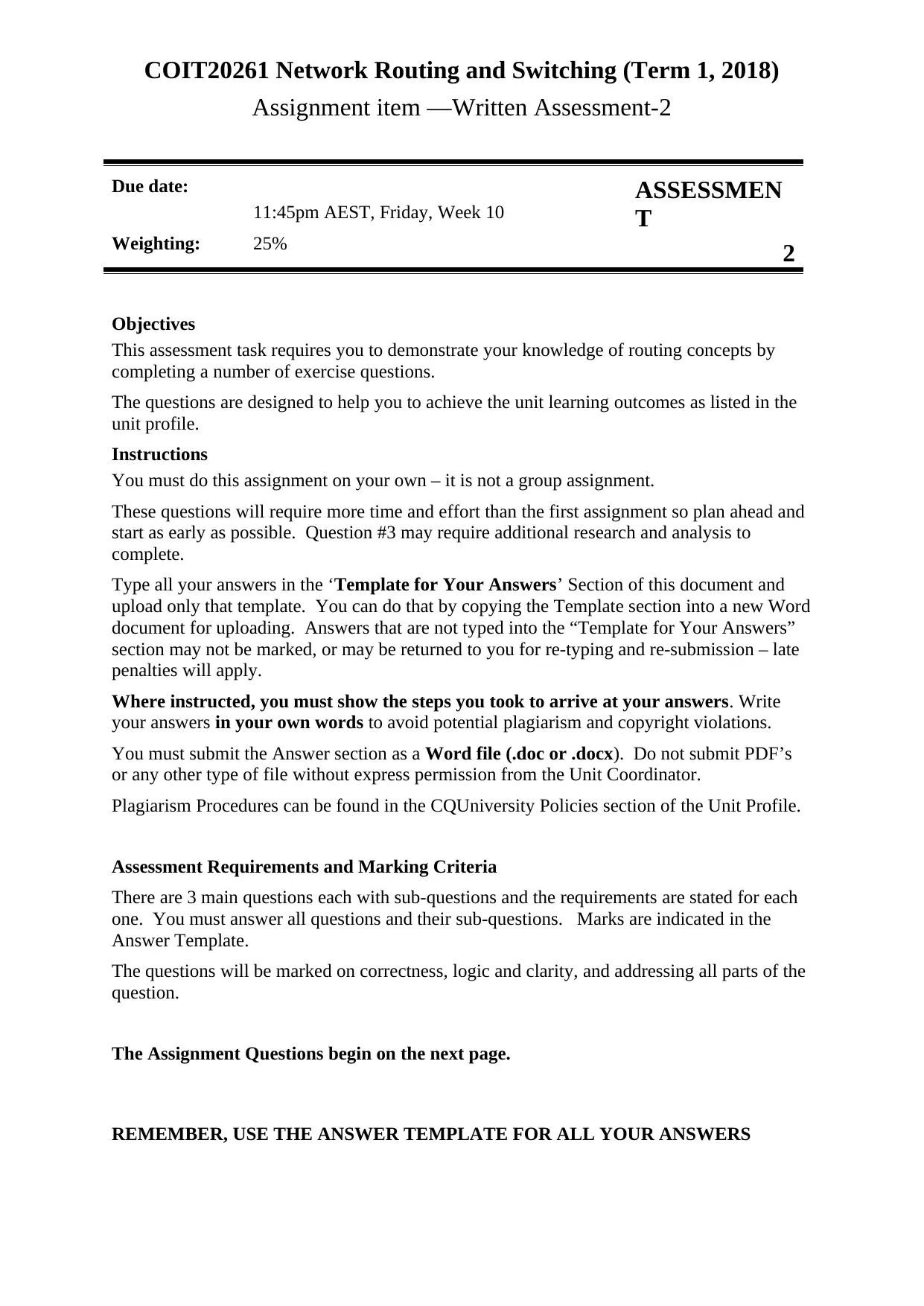
COIT20261 Network Routing and Switching (Term 1, 2018)
Assignment item —Written Assessment-2
Due date:
11:45pm AEST, Friday, Week 10
ASSESSMEN
T
Weighting: 25% 2
Objectives
This assessment task requires you to demonstrate your knowledge of routing concepts by
completing a number of exercise questions.
The questions are designed to help you to achieve the unit learning outcomes as listed in the
unit profile.
Instructions
You must do this assignment on your own – it is not a group assignment.
These questions will require more time and effort than the first assignment so plan ahead and
start as early as possible. Question #3 may require additional research and analysis to
complete.
Type all your answers in the ‘Template for Your Answers’ Section of this document and
upload only that template. You can do that by copying the Template section into a new Word
document for uploading. Answers that are not typed into the “Template for Your Answers”
section may not be marked, or may be returned to you for re-typing and re-submission – late
penalties will apply.
Where instructed, you must show the steps you took to arrive at your answers. Write
your answers in your own words to avoid potential plagiarism and copyright violations.
You must submit the Answer section as a Word file (.doc or .docx). Do not submit PDF’s
or any other type of file without express permission from the Unit Coordinator.
Plagiarism Procedures can be found in the CQUniversity Policies section of the Unit Profile.
Assessment Requirements and Marking Criteria
There are 3 main questions each with sub-questions and the requirements are stated for each
one. You must answer all questions and their sub-questions. Marks are indicated in the
Answer Template.
The questions will be marked on correctness, logic and clarity, and addressing all parts of the
question.
The Assignment Questions begin on the next page.
REMEMBER, USE THE ANSWER TEMPLATE FOR ALL YOUR ANSWERS
Assignment item —Written Assessment-2
Due date:
11:45pm AEST, Friday, Week 10
ASSESSMEN
T
Weighting: 25% 2
Objectives
This assessment task requires you to demonstrate your knowledge of routing concepts by
completing a number of exercise questions.
The questions are designed to help you to achieve the unit learning outcomes as listed in the
unit profile.
Instructions
You must do this assignment on your own – it is not a group assignment.
These questions will require more time and effort than the first assignment so plan ahead and
start as early as possible. Question #3 may require additional research and analysis to
complete.
Type all your answers in the ‘Template for Your Answers’ Section of this document and
upload only that template. You can do that by copying the Template section into a new Word
document for uploading. Answers that are not typed into the “Template for Your Answers”
section may not be marked, or may be returned to you for re-typing and re-submission – late
penalties will apply.
Where instructed, you must show the steps you took to arrive at your answers. Write
your answers in your own words to avoid potential plagiarism and copyright violations.
You must submit the Answer section as a Word file (.doc or .docx). Do not submit PDF’s
or any other type of file without express permission from the Unit Coordinator.
Plagiarism Procedures can be found in the CQUniversity Policies section of the Unit Profile.
Assessment Requirements and Marking Criteria
There are 3 main questions each with sub-questions and the requirements are stated for each
one. You must answer all questions and their sub-questions. Marks are indicated in the
Answer Template.
The questions will be marked on correctness, logic and clarity, and addressing all parts of the
question.
The Assignment Questions begin on the next page.
REMEMBER, USE THE ANSWER TEMPLATE FOR ALL YOUR ANSWERS
Paraphrase This Document
Need a fresh take? Get an instant paraphrase of this document with our AI Paraphraser
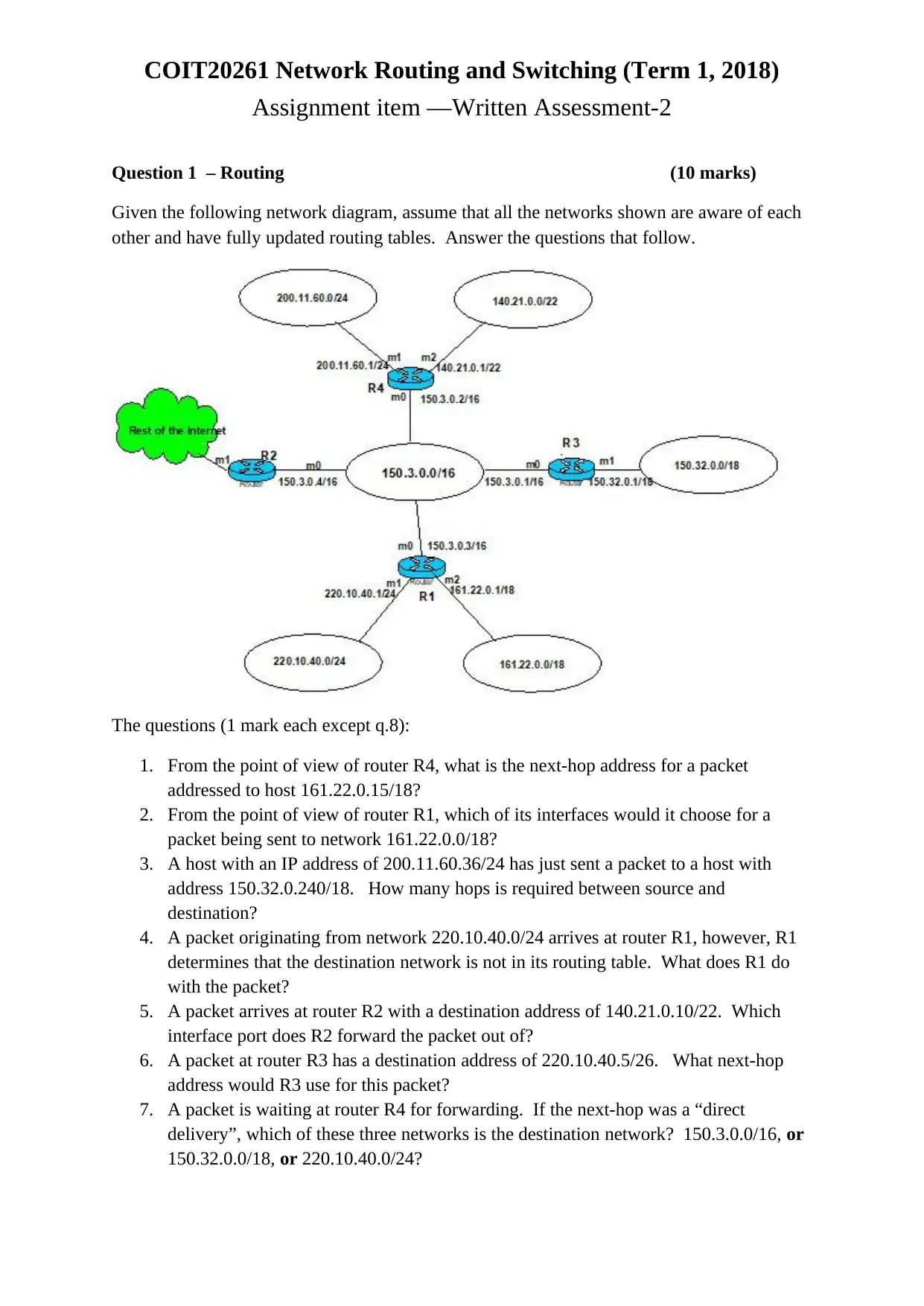
COIT20261 Network Routing and Switching (Term 1, 2018)
Assignment item —Written Assessment-2
Question 1 – Routing (10 marks)
Given the following network diagram, assume that all the networks shown are aware of each
other and have fully updated routing tables. Answer the questions that follow.
The questions (1 mark each except q.8):
1. From the point of view of router R4, what is the next-hop address for a packet
addressed to host 161.22.0.15/18?
2. From the point of view of router R1, which of its interfaces would it choose for a
packet being sent to network 161.22.0.0/18?
3. A host with an IP address of 200.11.60.36/24 has just sent a packet to a host with
address 150.32.0.240/18. How many hops is required between source and
destination?
4. A packet originating from network 220.10.40.0/24 arrives at router R1, however, R1
determines that the destination network is not in its routing table. What does R1 do
with the packet?
5. A packet arrives at router R2 with a destination address of 140.21.0.10/22. Which
interface port does R2 forward the packet out of?
6. A packet at router R3 has a destination address of 220.10.40.5/26. What next-hop
address would R3 use for this packet?
7. A packet is waiting at router R4 for forwarding. If the next-hop was a “direct
delivery”, which of these three networks is the destination network? 150.3.0.0/16, or
150.32.0.0/18, or 220.10.40.0/24?
Assignment item —Written Assessment-2
Question 1 – Routing (10 marks)
Given the following network diagram, assume that all the networks shown are aware of each
other and have fully updated routing tables. Answer the questions that follow.
The questions (1 mark each except q.8):
1. From the point of view of router R4, what is the next-hop address for a packet
addressed to host 161.22.0.15/18?
2. From the point of view of router R1, which of its interfaces would it choose for a
packet being sent to network 161.22.0.0/18?
3. A host with an IP address of 200.11.60.36/24 has just sent a packet to a host with
address 150.32.0.240/18. How many hops is required between source and
destination?
4. A packet originating from network 220.10.40.0/24 arrives at router R1, however, R1
determines that the destination network is not in its routing table. What does R1 do
with the packet?
5. A packet arrives at router R2 with a destination address of 140.21.0.10/22. Which
interface port does R2 forward the packet out of?
6. A packet at router R3 has a destination address of 220.10.40.5/26. What next-hop
address would R3 use for this packet?
7. A packet is waiting at router R4 for forwarding. If the next-hop was a “direct
delivery”, which of these three networks is the destination network? 150.3.0.0/16, or
150.32.0.0/18, or 220.10.40.0/24?
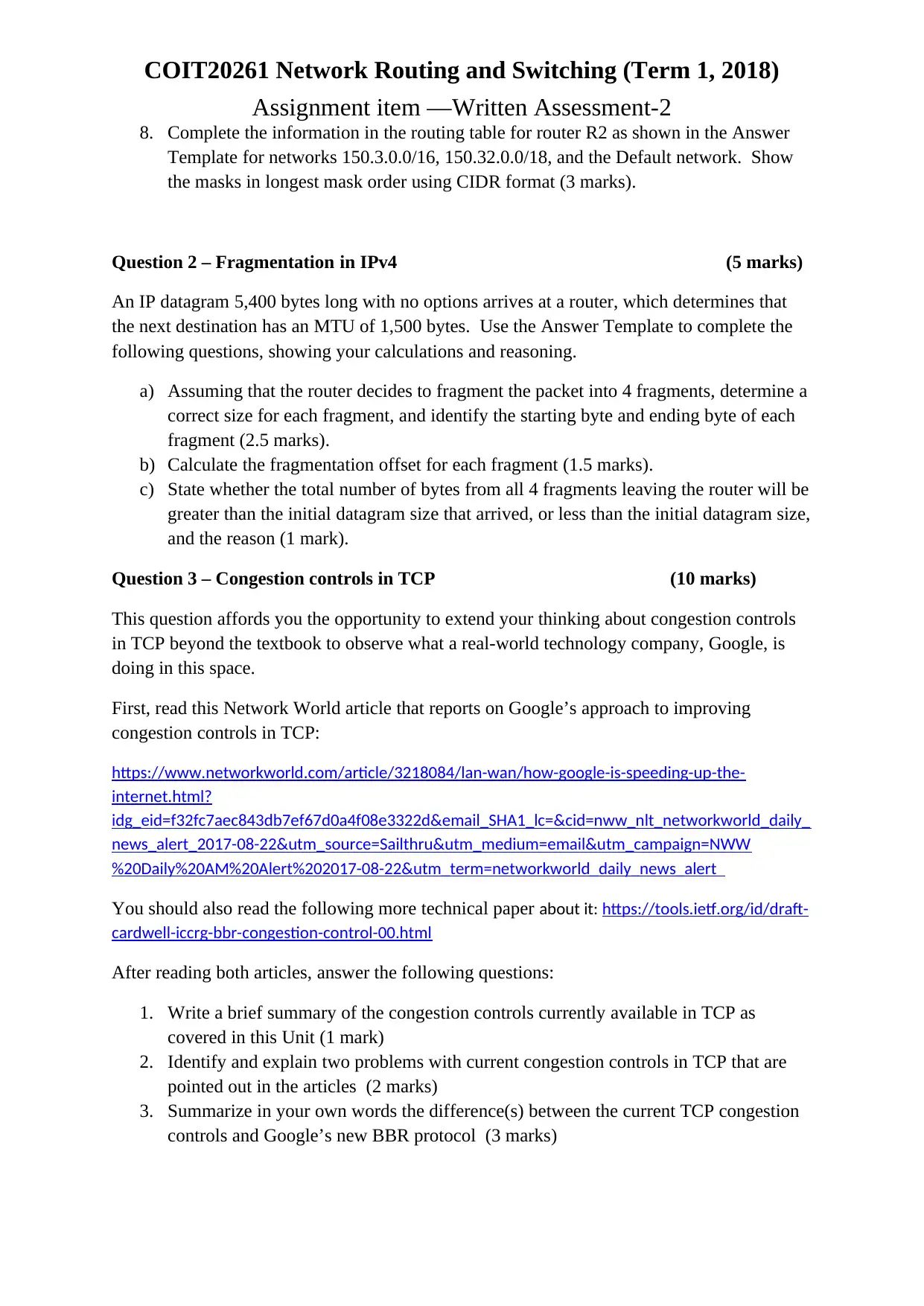
COIT20261 Network Routing and Switching (Term 1, 2018)
Assignment item —Written Assessment-2
8. Complete the information in the routing table for router R2 as shown in the Answer
Template for networks 150.3.0.0/16, 150.32.0.0/18, and the Default network. Show
the masks in longest mask order using CIDR format (3 marks).
Question 2 – Fragmentation in IPv4 (5 marks)
An IP datagram 5,400 bytes long with no options arrives at a router, which determines that
the next destination has an MTU of 1,500 bytes. Use the Answer Template to complete the
following questions, showing your calculations and reasoning.
a) Assuming that the router decides to fragment the packet into 4 fragments, determine a
correct size for each fragment, and identify the starting byte and ending byte of each
fragment (2.5 marks).
b) Calculate the fragmentation offset for each fragment (1.5 marks).
c) State whether the total number of bytes from all 4 fragments leaving the router will be
greater than the initial datagram size that arrived, or less than the initial datagram size,
and the reason (1 mark).
Question 3 – Congestion controls in TCP (10 marks)
This question affords you the opportunity to extend your thinking about congestion controls
in TCP beyond the textbook to observe what a real-world technology company, Google, is
doing in this space.
First, read this Network World article that reports on Google’s approach to improving
congestion controls in TCP:
https://www.networkworld.com/article/3218084/lan-wan/how-google-is-speeding-up-the-
internet.html?
idg_eid=f32fc7aec843db7ef67d0a4f08e3322d&email_SHA1_lc=&cid=nww_nlt_networkworld_daily_
news_alert_2017-08-22&utm_source=Sailthru&utm_medium=email&utm_campaign=NWW
%20Daily%20AM%20Alert%202017-08-22&utm_term=networkworld_daily_news_alert
You should also read the following more technical paper about it: https://tools.ietf.org/id/draft-
cardwell-iccrg-bbr-congestion-control-00.html
After reading both articles, answer the following questions:
1. Write a brief summary of the congestion controls currently available in TCP as
covered in this Unit (1 mark)
2. Identify and explain two problems with current congestion controls in TCP that are
pointed out in the articles (2 marks)
3. Summarize in your own words the difference(s) between the current TCP congestion
controls and Google’s new BBR protocol (3 marks)
Assignment item —Written Assessment-2
8. Complete the information in the routing table for router R2 as shown in the Answer
Template for networks 150.3.0.0/16, 150.32.0.0/18, and the Default network. Show
the masks in longest mask order using CIDR format (3 marks).
Question 2 – Fragmentation in IPv4 (5 marks)
An IP datagram 5,400 bytes long with no options arrives at a router, which determines that
the next destination has an MTU of 1,500 bytes. Use the Answer Template to complete the
following questions, showing your calculations and reasoning.
a) Assuming that the router decides to fragment the packet into 4 fragments, determine a
correct size for each fragment, and identify the starting byte and ending byte of each
fragment (2.5 marks).
b) Calculate the fragmentation offset for each fragment (1.5 marks).
c) State whether the total number of bytes from all 4 fragments leaving the router will be
greater than the initial datagram size that arrived, or less than the initial datagram size,
and the reason (1 mark).
Question 3 – Congestion controls in TCP (10 marks)
This question affords you the opportunity to extend your thinking about congestion controls
in TCP beyond the textbook to observe what a real-world technology company, Google, is
doing in this space.
First, read this Network World article that reports on Google’s approach to improving
congestion controls in TCP:
https://www.networkworld.com/article/3218084/lan-wan/how-google-is-speeding-up-the-
internet.html?
idg_eid=f32fc7aec843db7ef67d0a4f08e3322d&email_SHA1_lc=&cid=nww_nlt_networkworld_daily_
news_alert_2017-08-22&utm_source=Sailthru&utm_medium=email&utm_campaign=NWW
%20Daily%20AM%20Alert%202017-08-22&utm_term=networkworld_daily_news_alert
You should also read the following more technical paper about it: https://tools.ietf.org/id/draft-
cardwell-iccrg-bbr-congestion-control-00.html
After reading both articles, answer the following questions:
1. Write a brief summary of the congestion controls currently available in TCP as
covered in this Unit (1 mark)
2. Identify and explain two problems with current congestion controls in TCP that are
pointed out in the articles (2 marks)
3. Summarize in your own words the difference(s) between the current TCP congestion
controls and Google’s new BBR protocol (3 marks)
⊘ This is a preview!⊘
Do you want full access?
Subscribe today to unlock all pages.

Trusted by 1+ million students worldwide
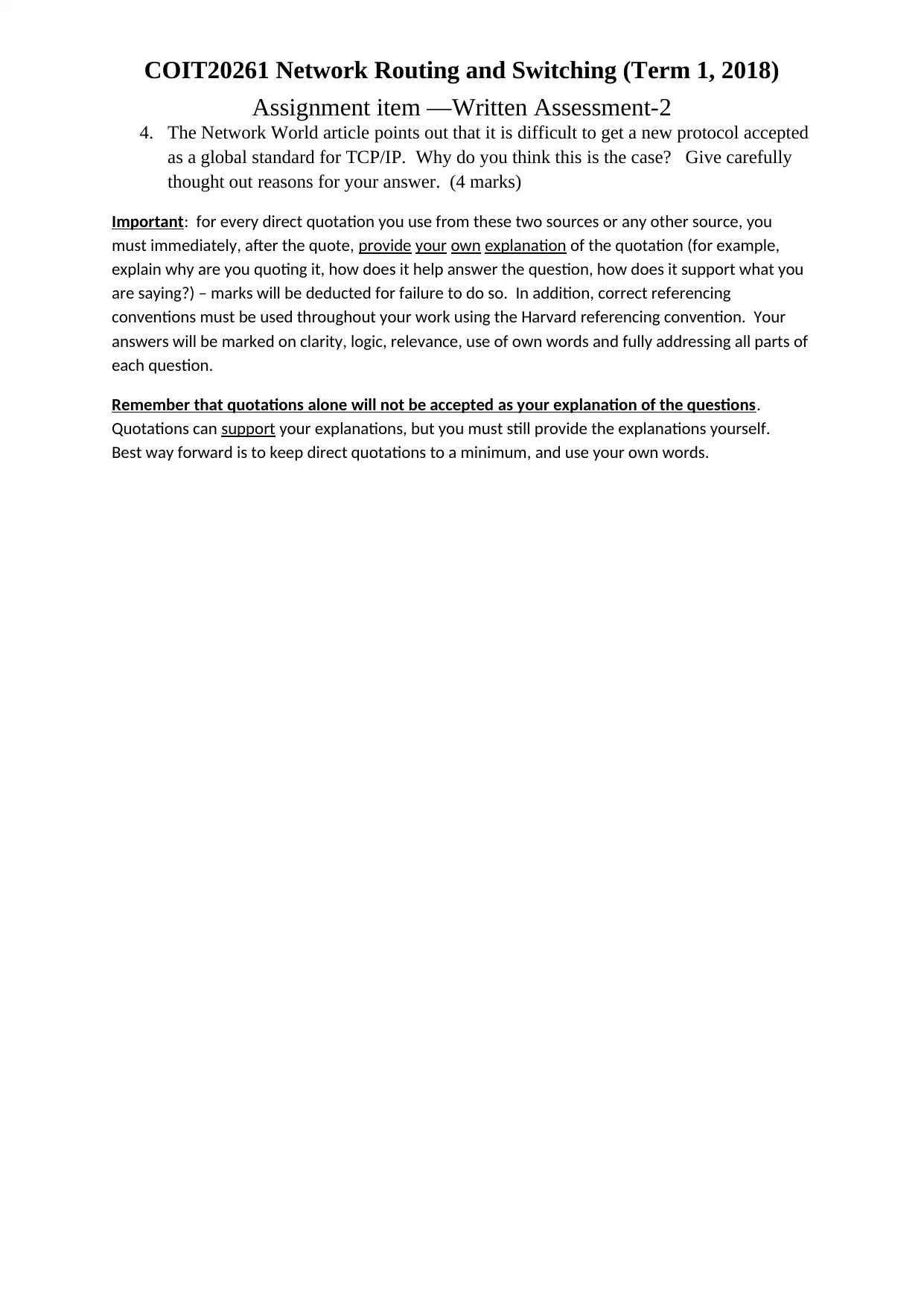
COIT20261 Network Routing and Switching (Term 1, 2018)
Assignment item —Written Assessment-2
4. The Network World article points out that it is difficult to get a new protocol accepted
as a global standard for TCP/IP. Why do you think this is the case? Give carefully
thought out reasons for your answer. (4 marks)
Important: for every direct quotation you use from these two sources or any other source, you
must immediately, after the quote, provide your own explanation of the quotation (for example,
explain why are you quoting it, how does it help answer the question, how does it support what you
are saying?) – marks will be deducted for failure to do so. In addition, correct referencing
conventions must be used throughout your work using the Harvard referencing convention. Your
answers will be marked on clarity, logic, relevance, use of own words and fully addressing all parts of
each question.
Remember that quotations alone will not be accepted as your explanation of the questions.
Quotations can support your explanations, but you must still provide the explanations yourself.
Best way forward is to keep direct quotations to a minimum, and use your own words.
Assignment item —Written Assessment-2
4. The Network World article points out that it is difficult to get a new protocol accepted
as a global standard for TCP/IP. Why do you think this is the case? Give carefully
thought out reasons for your answer. (4 marks)
Important: for every direct quotation you use from these two sources or any other source, you
must immediately, after the quote, provide your own explanation of the quotation (for example,
explain why are you quoting it, how does it help answer the question, how does it support what you
are saying?) – marks will be deducted for failure to do so. In addition, correct referencing
conventions must be used throughout your work using the Harvard referencing convention. Your
answers will be marked on clarity, logic, relevance, use of own words and fully addressing all parts of
each question.
Remember that quotations alone will not be accepted as your explanation of the questions.
Quotations can support your explanations, but you must still provide the explanations yourself.
Best way forward is to keep direct quotations to a minimum, and use your own words.
Paraphrase This Document
Need a fresh take? Get an instant paraphrase of this document with our AI Paraphraser
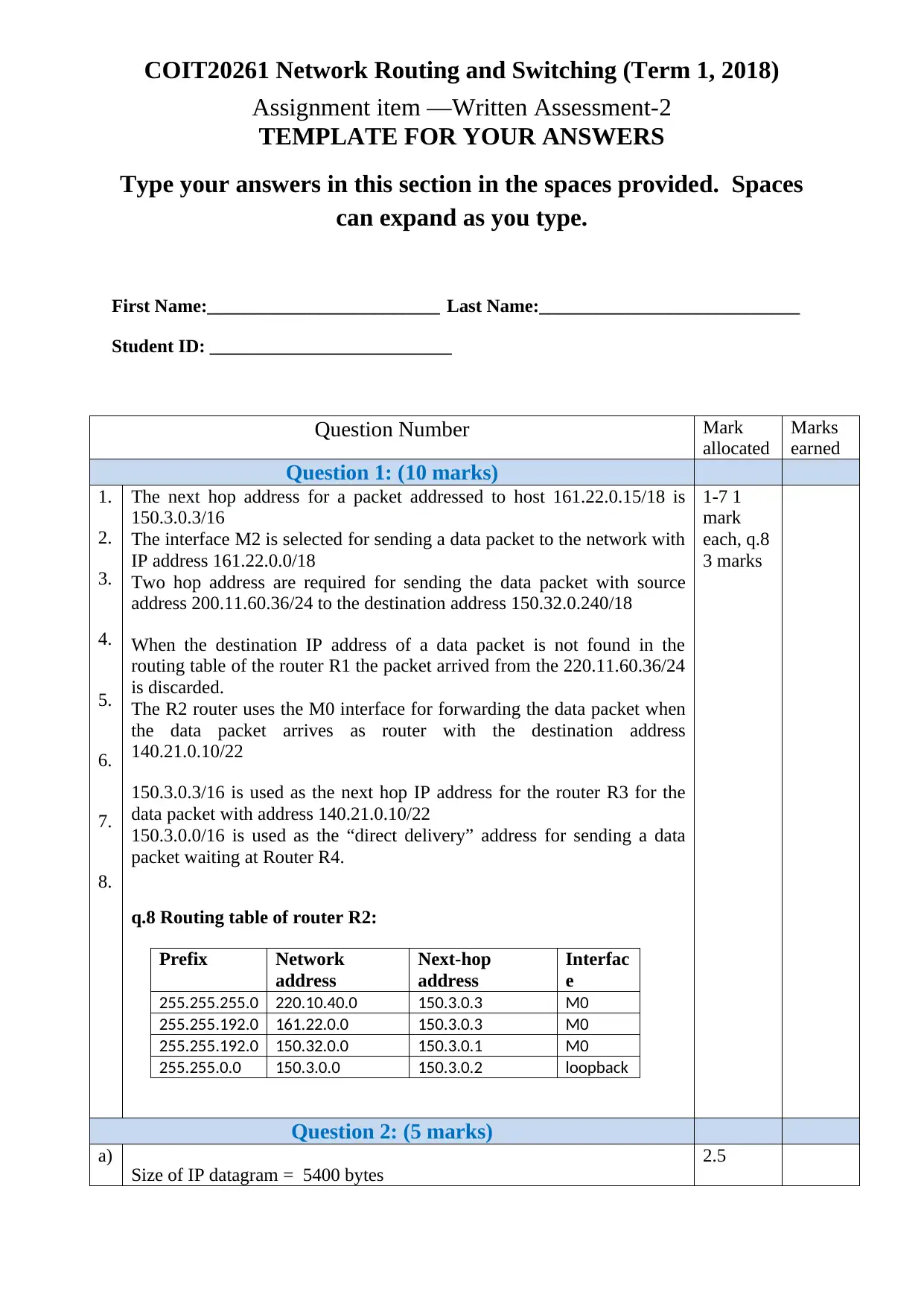
COIT20261 Network Routing and Switching (Term 1, 2018)
Assignment item —Written Assessment-2
TEMPLATE FOR YOUR ANSWERS
Type your answers in this section in the spaces provided. Spaces
can expand as you type.
First Name:_________________________ Last Name:____________________________
Student ID: __________________________
Question Number Mark
allocated
Marks
earned
Question 1: (10 marks)
1.
2.
3.
4.
5.
6.
7.
8.
The next hop address for a packet addressed to host 161.22.0.15/18 is
150.3.0.3/16
The interface M2 is selected for sending a data packet to the network with
IP address 161.22.0.0/18
Two hop address are required for sending the data packet with source
address 200.11.60.36/24 to the destination address 150.32.0.240/18
When the destination IP address of a data packet is not found in the
routing table of the router R1 the packet arrived from the 220.11.60.36/24
is discarded.
The R2 router uses the M0 interface for forwarding the data packet when
the data packet arrives as router with the destination address
140.21.0.10/22
150.3.0.3/16 is used as the next hop IP address for the router R3 for the
data packet with address 140.21.0.10/22
150.3.0.0/16 is used as the “direct delivery” address for sending a data
packet waiting at Router R4.
q.8 Routing table of router R2:
Prefix Network
address
Next-hop
address
Interfac
e
255.255.255.0 220.10.40.0 150.3.0.3 M0
255.255.192.0 161.22.0.0 150.3.0.3 M0
255.255.192.0 150.32.0.0 150.3.0.1 M0
255.255.0.0 150.3.0.0 150.3.0.2 loopback
1-7 1
mark
each, q.8
3 marks
Question 2: (5 marks)
a)
Size of IP datagram = 5400 bytes
2.5
Assignment item —Written Assessment-2
TEMPLATE FOR YOUR ANSWERS
Type your answers in this section in the spaces provided. Spaces
can expand as you type.
First Name:_________________________ Last Name:____________________________
Student ID: __________________________
Question Number Mark
allocated
Marks
earned
Question 1: (10 marks)
1.
2.
3.
4.
5.
6.
7.
8.
The next hop address for a packet addressed to host 161.22.0.15/18 is
150.3.0.3/16
The interface M2 is selected for sending a data packet to the network with
IP address 161.22.0.0/18
Two hop address are required for sending the data packet with source
address 200.11.60.36/24 to the destination address 150.32.0.240/18
When the destination IP address of a data packet is not found in the
routing table of the router R1 the packet arrived from the 220.11.60.36/24
is discarded.
The R2 router uses the M0 interface for forwarding the data packet when
the data packet arrives as router with the destination address
140.21.0.10/22
150.3.0.3/16 is used as the next hop IP address for the router R3 for the
data packet with address 140.21.0.10/22
150.3.0.0/16 is used as the “direct delivery” address for sending a data
packet waiting at Router R4.
q.8 Routing table of router R2:
Prefix Network
address
Next-hop
address
Interfac
e
255.255.255.0 220.10.40.0 150.3.0.3 M0
255.255.192.0 161.22.0.0 150.3.0.3 M0
255.255.192.0 150.32.0.0 150.3.0.1 M0
255.255.0.0 150.3.0.0 150.3.0.2 loopback
1-7 1
mark
each, q.8
3 marks
Question 2: (5 marks)
a)
Size of IP datagram = 5400 bytes
2.5
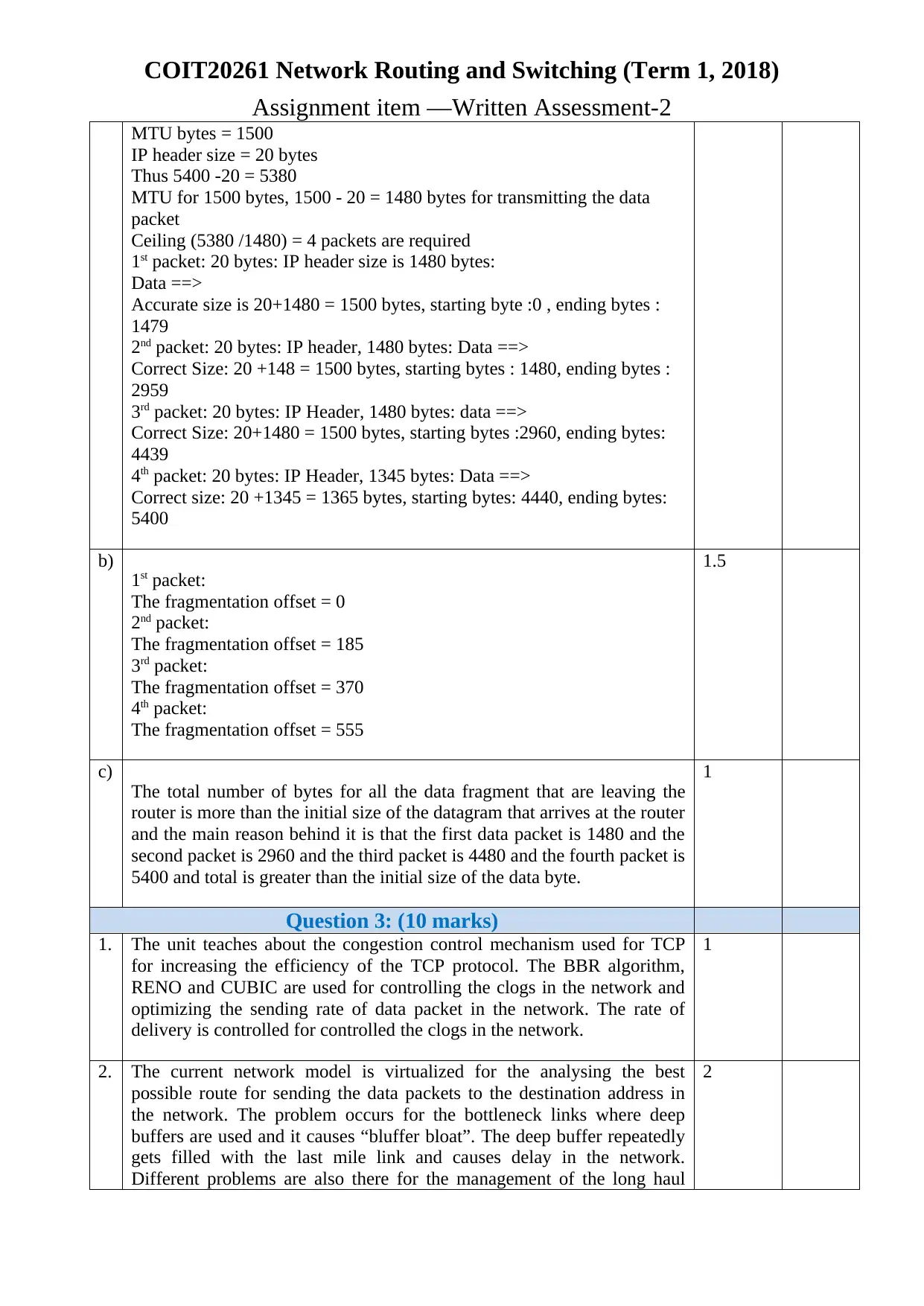
COIT20261 Network Routing and Switching (Term 1, 2018)
Assignment item —Written Assessment-2
MTU bytes = 1500
IP header size = 20 bytes
Thus 5400 -20 = 5380
MTU for 1500 bytes, 1500 - 20 = 1480 bytes for transmitting the data
packet
Ceiling (5380 /1480) = 4 packets are required
1st packet: 20 bytes: IP header size is 1480 bytes:
Data ==>
Accurate size is 20+1480 = 1500 bytes, starting byte :0 , ending bytes :
1479
2nd packet: 20 bytes: IP header, 1480 bytes: Data ==>
Correct Size: 20 +148 = 1500 bytes, starting bytes : 1480, ending bytes :
2959
3rd packet: 20 bytes: IP Header, 1480 bytes: data ==>
Correct Size: 20+1480 = 1500 bytes, starting bytes :2960, ending bytes:
4439
4th packet: 20 bytes: IP Header, 1345 bytes: Data ==>
Correct size: 20 +1345 = 1365 bytes, starting bytes: 4440, ending bytes:
5400
b)
1st packet:
The fragmentation offset = 0
2nd packet:
The fragmentation offset = 185
3rd packet:
The fragmentation offset = 370
4th packet:
The fragmentation offset = 555
1.5
c)
The total number of bytes for all the data fragment that are leaving the
router is more than the initial size of the datagram that arrives at the router
and the main reason behind it is that the first data packet is 1480 and the
second packet is 2960 and the third packet is 4480 and the fourth packet is
5400 and total is greater than the initial size of the data byte.
1
Question 3: (10 marks)
1. The unit teaches about the congestion control mechanism used for TCP
for increasing the efficiency of the TCP protocol. The BBR algorithm,
RENO and CUBIC are used for controlling the clogs in the network and
optimizing the sending rate of data packet in the network. The rate of
delivery is controlled for controlled the clogs in the network.
1
2. The current network model is virtualized for the analysing the best
possible route for sending the data packets to the destination address in
the network. The problem occurs for the bottleneck links where deep
buffers are used and it causes “bluffer bloat”. The deep buffer repeatedly
gets filled with the last mile link and causes delay in the network.
Different problems are also there for the management of the long haul
2
Assignment item —Written Assessment-2
MTU bytes = 1500
IP header size = 20 bytes
Thus 5400 -20 = 5380
MTU for 1500 bytes, 1500 - 20 = 1480 bytes for transmitting the data
packet
Ceiling (5380 /1480) = 4 packets are required
1st packet: 20 bytes: IP header size is 1480 bytes:
Data ==>
Accurate size is 20+1480 = 1500 bytes, starting byte :0 , ending bytes :
1479
2nd packet: 20 bytes: IP header, 1480 bytes: Data ==>
Correct Size: 20 +148 = 1500 bytes, starting bytes : 1480, ending bytes :
2959
3rd packet: 20 bytes: IP Header, 1480 bytes: data ==>
Correct Size: 20+1480 = 1500 bytes, starting bytes :2960, ending bytes:
4439
4th packet: 20 bytes: IP Header, 1345 bytes: Data ==>
Correct size: 20 +1345 = 1365 bytes, starting bytes: 4440, ending bytes:
5400
b)
1st packet:
The fragmentation offset = 0
2nd packet:
The fragmentation offset = 185
3rd packet:
The fragmentation offset = 370
4th packet:
The fragmentation offset = 555
1.5
c)
The total number of bytes for all the data fragment that are leaving the
router is more than the initial size of the datagram that arrives at the router
and the main reason behind it is that the first data packet is 1480 and the
second packet is 2960 and the third packet is 4480 and the fourth packet is
5400 and total is greater than the initial size of the data byte.
1
Question 3: (10 marks)
1. The unit teaches about the congestion control mechanism used for TCP
for increasing the efficiency of the TCP protocol. The BBR algorithm,
RENO and CUBIC are used for controlling the clogs in the network and
optimizing the sending rate of data packet in the network. The rate of
delivery is controlled for controlled the clogs in the network.
1
2. The current network model is virtualized for the analysing the best
possible route for sending the data packets to the destination address in
the network. The problem occurs for the bottleneck links where deep
buffers are used and it causes “bluffer bloat”. The deep buffer repeatedly
gets filled with the last mile link and causes delay in the network.
Different problems are also there for the management of the long haul
2
⊘ This is a preview!⊘
Do you want full access?
Subscribe today to unlock all pages.

Trusted by 1+ million students worldwide
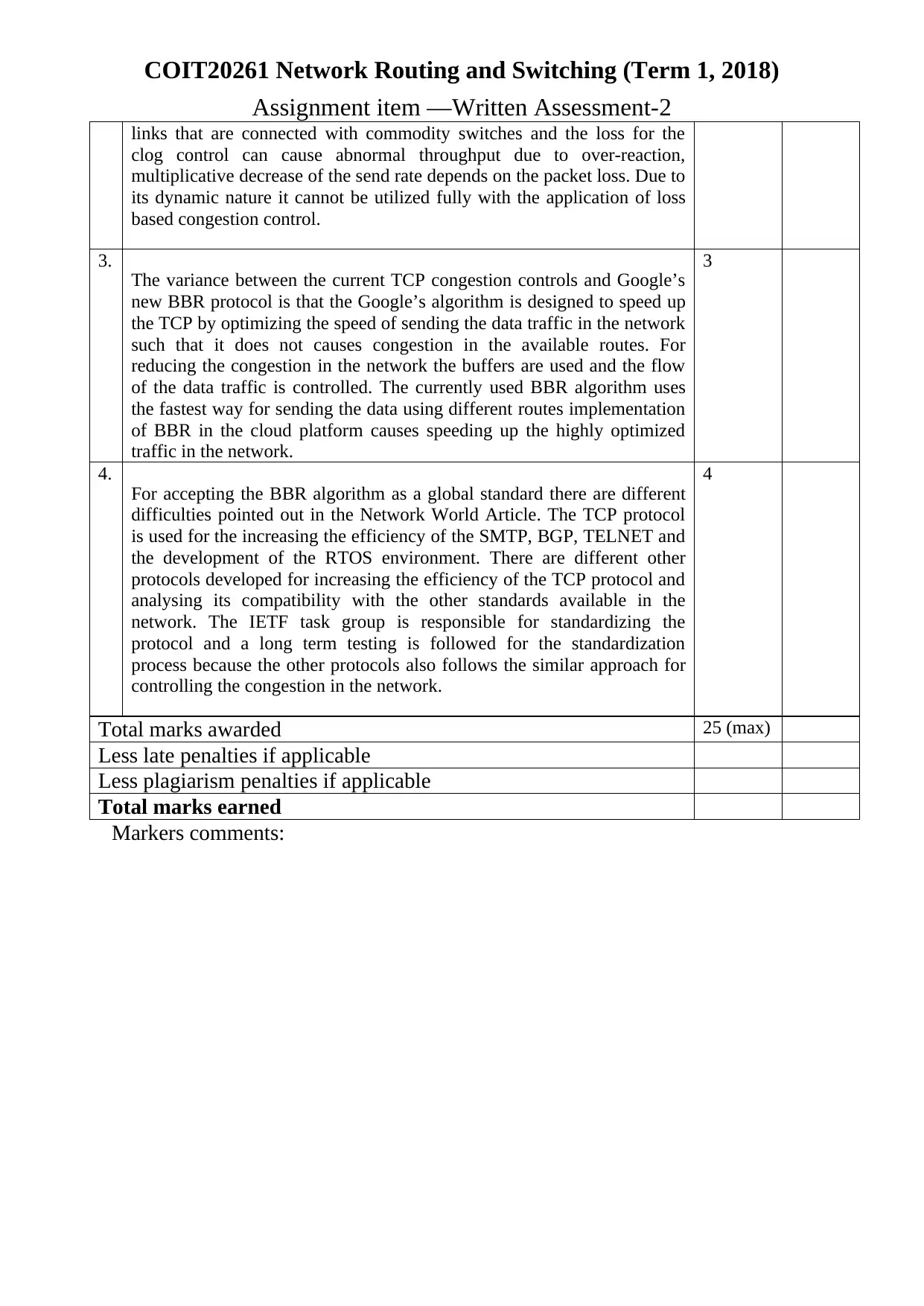
COIT20261 Network Routing and Switching (Term 1, 2018)
Assignment item —Written Assessment-2
links that are connected with commodity switches and the loss for the
clog control can cause abnormal throughput due to over-reaction,
multiplicative decrease of the send rate depends on the packet loss. Due to
its dynamic nature it cannot be utilized fully with the application of loss
based congestion control.
3.
The variance between the current TCP congestion controls and Google’s
new BBR protocol is that the Google’s algorithm is designed to speed up
the TCP by optimizing the speed of sending the data traffic in the network
such that it does not causes congestion in the available routes. For
reducing the congestion in the network the buffers are used and the flow
of the data traffic is controlled. The currently used BBR algorithm uses
the fastest way for sending the data using different routes implementation
of BBR in the cloud platform causes speeding up the highly optimized
traffic in the network.
3
4.
For accepting the BBR algorithm as a global standard there are different
difficulties pointed out in the Network World Article. The TCP protocol
is used for the increasing the efficiency of the SMTP, BGP, TELNET and
the development of the RTOS environment. There are different other
protocols developed for increasing the efficiency of the TCP protocol and
analysing its compatibility with the other standards available in the
network. The IETF task group is responsible for standardizing the
protocol and a long term testing is followed for the standardization
process because the other protocols also follows the similar approach for
controlling the congestion in the network.
4
Total marks awarded 25 (max)
Less late penalties if applicable
Less plagiarism penalties if applicable
Total marks earned
Markers comments:
Assignment item —Written Assessment-2
links that are connected with commodity switches and the loss for the
clog control can cause abnormal throughput due to over-reaction,
multiplicative decrease of the send rate depends on the packet loss. Due to
its dynamic nature it cannot be utilized fully with the application of loss
based congestion control.
3.
The variance between the current TCP congestion controls and Google’s
new BBR protocol is that the Google’s algorithm is designed to speed up
the TCP by optimizing the speed of sending the data traffic in the network
such that it does not causes congestion in the available routes. For
reducing the congestion in the network the buffers are used and the flow
of the data traffic is controlled. The currently used BBR algorithm uses
the fastest way for sending the data using different routes implementation
of BBR in the cloud platform causes speeding up the highly optimized
traffic in the network.
3
4.
For accepting the BBR algorithm as a global standard there are different
difficulties pointed out in the Network World Article. The TCP protocol
is used for the increasing the efficiency of the SMTP, BGP, TELNET and
the development of the RTOS environment. There are different other
protocols developed for increasing the efficiency of the TCP protocol and
analysing its compatibility with the other standards available in the
network. The IETF task group is responsible for standardizing the
protocol and a long term testing is followed for the standardization
process because the other protocols also follows the similar approach for
controlling the congestion in the network.
4
Total marks awarded 25 (max)
Less late penalties if applicable
Less plagiarism penalties if applicable
Total marks earned
Markers comments:
Paraphrase This Document
Need a fresh take? Get an instant paraphrase of this document with our AI Paraphraser
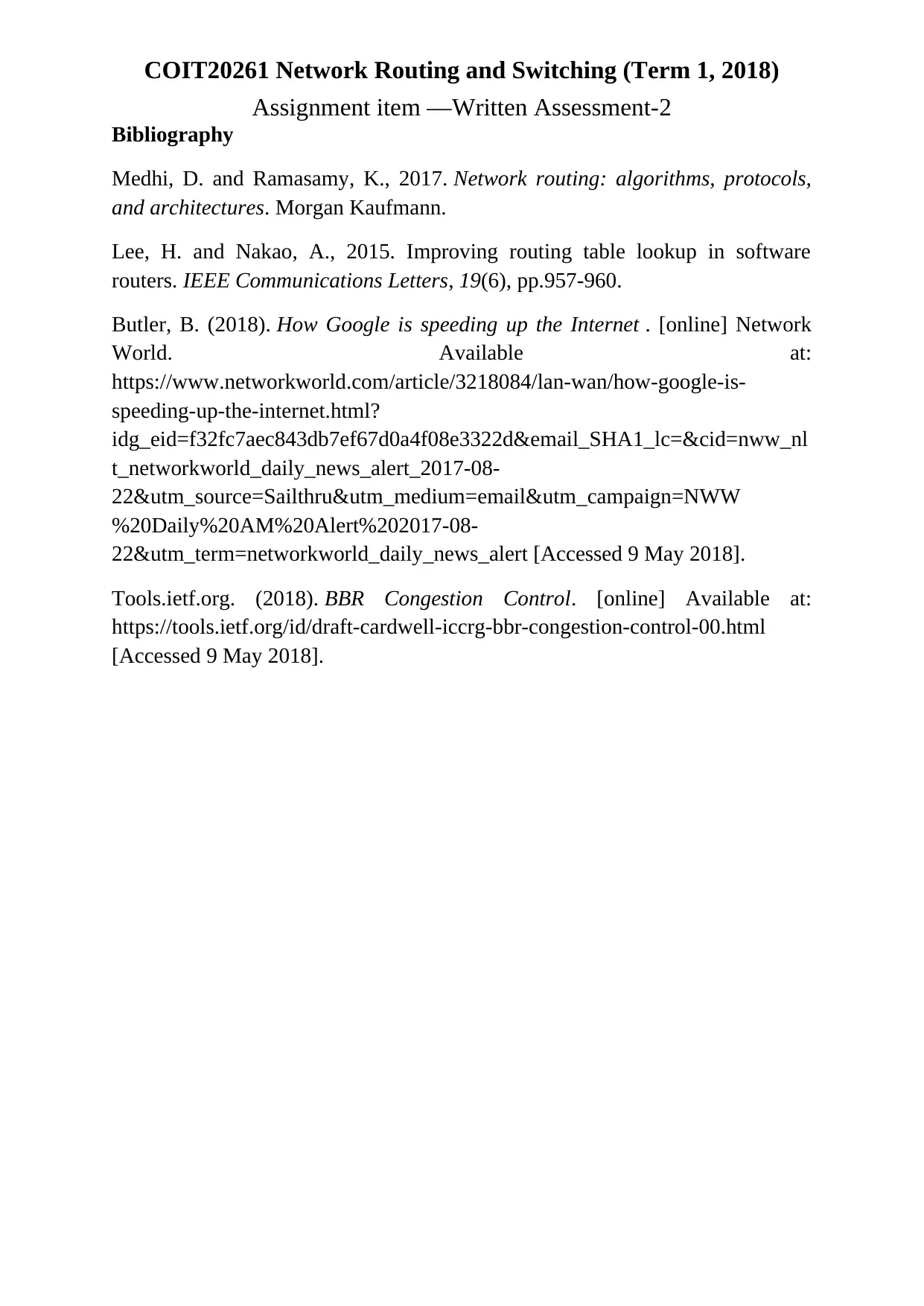
COIT20261 Network Routing and Switching (Term 1, 2018)
Assignment item —Written Assessment-2
Bibliography
Medhi, D. and Ramasamy, K., 2017. Network routing: algorithms, protocols,
and architectures. Morgan Kaufmann.
Lee, H. and Nakao, A., 2015. Improving routing table lookup in software
routers. IEEE Communications Letters, 19(6), pp.957-960.
Butler, B. (2018). How Google is speeding up the Internet . [online] Network
World. Available at:
https://www.networkworld.com/article/3218084/lan-wan/how-google-is-
speeding-up-the-internet.html?
idg_eid=f32fc7aec843db7ef67d0a4f08e3322d&email_SHA1_lc=&cid=nww_nl
t_networkworld_daily_news_alert_2017-08-
22&utm_source=Sailthru&utm_medium=email&utm_campaign=NWW
%20Daily%20AM%20Alert%202017-08-
22&utm_term=networkworld_daily_news_alert [Accessed 9 May 2018].
Tools.ietf.org. (2018). BBR Congestion Control. [online] Available at:
https://tools.ietf.org/id/draft-cardwell-iccrg-bbr-congestion-control-00.html
[Accessed 9 May 2018].
Assignment item —Written Assessment-2
Bibliography
Medhi, D. and Ramasamy, K., 2017. Network routing: algorithms, protocols,
and architectures. Morgan Kaufmann.
Lee, H. and Nakao, A., 2015. Improving routing table lookup in software
routers. IEEE Communications Letters, 19(6), pp.957-960.
Butler, B. (2018). How Google is speeding up the Internet . [online] Network
World. Available at:
https://www.networkworld.com/article/3218084/lan-wan/how-google-is-
speeding-up-the-internet.html?
idg_eid=f32fc7aec843db7ef67d0a4f08e3322d&email_SHA1_lc=&cid=nww_nl
t_networkworld_daily_news_alert_2017-08-
22&utm_source=Sailthru&utm_medium=email&utm_campaign=NWW
%20Daily%20AM%20Alert%202017-08-
22&utm_term=networkworld_daily_news_alert [Accessed 9 May 2018].
Tools.ietf.org. (2018). BBR Congestion Control. [online] Available at:
https://tools.ietf.org/id/draft-cardwell-iccrg-bbr-congestion-control-00.html
[Accessed 9 May 2018].
1 out of 8
Related Documents
Your All-in-One AI-Powered Toolkit for Academic Success.
+13062052269
info@desklib.com
Available 24*7 on WhatsApp / Email
![[object Object]](/_next/static/media/star-bottom.7253800d.svg)
Unlock your academic potential
Copyright © 2020–2025 A2Z Services. All Rights Reserved. Developed and managed by ZUCOL.





